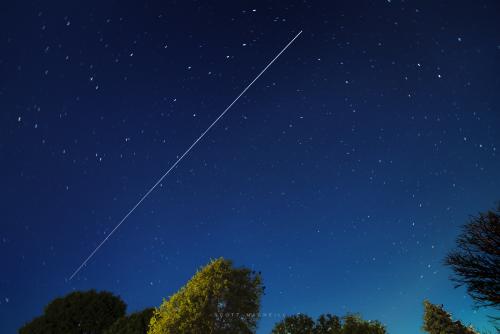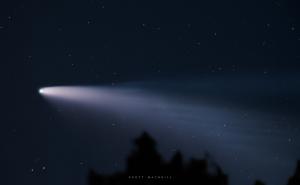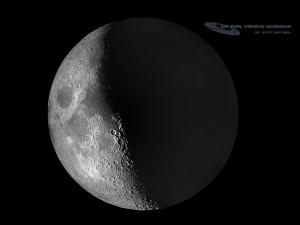Celebration of Space - January 15, 2021

The International Space Station passes over Cranston, RI by Frosty Drew Astronomy Team member Scott MacNeill
Now that we are entering the final month leading up to the NASA Mars 2020 Perseverance rover’s arrival at Mars, online excitement is starting to buzz. The mission of Mars 2020 is astrobiology, which deals with the origins and ancient evolution of life in the Universe. In the context of this mission, Perseverance will look for signs of ancient microbial life on Mars, collect samples, and potentially have those samples returned to Earth for further analysis. This is all rocket sauce, of course, but there are two very interesting components on board the Perseverance rover that will surely be all the rage once the rover arrives. Perseverance will deploy a rotorcraft (drone) for easier and more efficient investigations of the surrounding environment. The second, and potentially best device, are a set of microphones. These microphones will attempt to capture audio from the landing procedures of the rover, and possibly the overall audio of Mars – what it sounds like on Mars! Now the microphone components are not super crazy NASA stolen alien technology (that’s a joke..), these microphones are the same grade of hardware that we would purchase in a store, and are not expected to work beyond the landing operations of the rover. But they may, and if they do, we will be able to listen to the sounds of Mars for the first time ever. In the past we have been able to remap audio recordings to sounds that human ears can hear and understand, though what we hear is not what it would sound like there. Considering the differences in environments, the sound will still be a bit different than what we would hear on Earth, though it will be recorded the same way we record human accessible sound on Earth. What you won’t hear are aliens whispering about the rover, sorry QAnon you’re just hearing what you want to hear. Regardless, the arrival date at Mars, slated for February 18, 2021, is quickly approaching. So get excited for awesome happenings this winter! Perseverance launched on July 30, 2020 and is scheduled to land in the Jezero Crater on February 18, 2021.
Tomorrow evening, Saturday, January 16, 2021, the International Space Station (ISS) will commence daily evening passes over the United States, specifically the Northeast. Considering that we are still on the side of the year with early sunset times, this will allow for easily accessible, family friendly views of the ISS passing over our region. Catching sight of the ISS is really a cake walk, you have probably seen it several times and mistaken it for an airplane. All you need to know is what time to look and where to look. The ISS is very bright and can be seen even from urban locations with heavy light pollution. It will appear like a very bright star moving quickly across the sky. Speed-wise, it will appear to generally move about as fast as an aircraft (in reality it’s ripping by at 17,500 mph), but it will not have flashing lights like an aircraft does. Observers will also notice that the station will start to dim quickly and disappear from view before setting. This is because the station is only visible to Earth-bound viewers while it is still in sunlight. Once the station orbits into Earth’s shadow, it becomes invisible to the unaided eye. During this time, residents of the ISS are experiencing sunset. Now if you have some prowess with a telescope, you can manually track the ISS while observing, which will reveal station compartments and solar panels. Regardless of how you view – binoculars, telescope, or just with the naked eye, it is always a compelling and humbling view. Here are notable passes happening this weekend and coming week:
Sat, Jan 16 at 6:51 pm, starting in the SSW, rising to 17°, and into orbital sunset
Sun, Jan 17 at 6:04 pm, starting in the S, rising to 20°, and into orbital sunset
Mon, Jan 18 at 6:52 pm, starting in the SW, rising to 42°, and into orbital sunset
Tue, Jan 19 at 6:05 pm, starting in the SW, rising to 57°, heading towards the ENE, and into orbital sunset. ← Awesome Pass!
Wed, Jan 20 at 5:17 pm, starting in the SSW, rising to 32°, heading towards the ENE
Wed, Jan 20 at 6:54 om, starting in the W, rising to 32°, and into orbital sunset
Thu, Jan 21 at 6:06 pm, starting in the WSW, rising to 51°, heading towards the NE, and into orbital sunset ← Awesome Pass!
Times listed are applicable to Southern New England, and are generally acceptable for the entire Northeast. For times specific to your location, visit NASAs Spot the Station. Now put these times on your calendar, and set your alarm to remind you each night to gather your friends and / or family for a couple minutes of serious inspiration as you stand out under humanity’s only space based residency zooming by.
Of all the notable things that happened in 2020 (which was a fabulous year for Frosty Drew) I’m sure most of you remember Comet C/2020 F3 NEOWISE – the best naked eye visible comet in the Northern Hemisphere since Comet Hale-Bopp of 1997. Well a new comet has been discovered, named C/2021 A1 Leonard, which has the potential to be the next naked eye visible comet, and it will show up just in time for the winter holiday season. Comet Leonard was discovered by Greg Leonard at the Mount Lemmon Observatory in Arizona on January 3, 2021. Though numbers are still quite preliminary on this comet, it appears to have a hyperbolic orbit, which means that this will be the first and last time the comet will visit the inner Solar System, and that equates to some amazing possibilities. Since the comet may have never closely visited the Sun, it can become quite volatile with rapid outgassing happening once it encounters the intense solar winds of our neighborhood. This interaction could cause the nucleus to fracture, which will result in a stunning outburst of highly volatile material. The approach angle and inclination of the comet is not very optimal for post-perihelion viewing (after the comet swings around the Sun) in the Northern Hemisphere, but we do have an okay perihelion approach vantage point. Due to the comet’s inclination and that the comet reaches perihelion at 0.6 AU, which is closer to the Sun than Earth, we will get a nice approach view of any tail that may form from the comet’s interaction with the solar wind. The word on the street is that Comet Leonard already has a faint tail, which is good news in regards to the previous point about volatility. As the year progresses we will have a much better idea of how the comet is reacting to its new, yet brief, environment. Hopefully we will celebrate the second half of autumn 2021 with another stunning comet!
Over the next several evenings, be sure to step outside and check out the beautiful waxing crescent Moon. Each night, starting tonight, we will see the thin crescent phase increase in illumination. During the crescent stage, the Moon is a stunning sight for a couple of reasons. The first reason is that the Moon is not so bright that it outshines everything else in the sky. You can still have a relatively dark sky silhouetted by the crescent Moon. Secondly, the crescent Moon allows dim enough viewing conditions that Earthshine becomes strikingly visible. Earthshine is when we can see the shadow side of the Moon, the area in night, due to bright sunlight reflected off of Earth. This reflected sunlight will illuminate the nighttime area of the Moon enough for us to see it alongside the much brighter crescent. The view will be happening over the weekend and into the first half of the coming week. So get out there about an hour after sunset each night and look to the SW sky for your moment with Earth’s only natural satellite.
-Scott
- Author:
- Scott MacNeill
- Entry Date:
- Jan 15, 2021
- Published Under:
- Scott MacNeill's Columns




